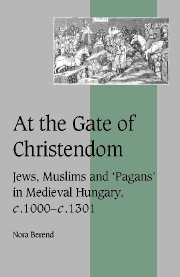Book contents
- Frontmatter
- Contents
- List of maps
- Acknowledgements
- List of abbreviations
- INTRODUCTION
- 1 HUNGARY: A FRONTIER SOCIETY
- 2 CHRISTIANS AND NON-CHRISTIANS
- 3 THE LEGAL POSITION OF HUNGARY'S NON-CHRISTIAN POPULATION
- 4 NON-CHRISTIANS IN HUNGARIAN ECONOMY AND SOCIETY
- 5 CONFLICTS BETWEEN THE PAPACY AND THE KINGS
- 6 CHRISTIAN PERCEPTIONS AND ATTITUDES
- 7 NON-CHRISTIAN COMMUNITIES: CONTINUITY, TRANSFORMATION, CONVERSION AND ASSIMILATION
- CONCLUSION
- Appendix 1 Hungarian kings of the house of Árpád
- Appendix 2 Toponyms, with Latin and German equivalents
- Appendix 3 The manuscript tradition of the Synod of Buda (1279)
- Bibliography
- Index
- Cambridge Studies in Medieval Life and Thought Fourth series
6 - CHRISTIAN PERCEPTIONS AND ATTITUDES
Published online by Cambridge University Press: 06 January 2010
- Frontmatter
- Contents
- List of maps
- Acknowledgements
- List of abbreviations
- INTRODUCTION
- 1 HUNGARY: A FRONTIER SOCIETY
- 2 CHRISTIANS AND NON-CHRISTIANS
- 3 THE LEGAL POSITION OF HUNGARY'S NON-CHRISTIAN POPULATION
- 4 NON-CHRISTIANS IN HUNGARIAN ECONOMY AND SOCIETY
- 5 CONFLICTS BETWEEN THE PAPACY AND THE KINGS
- 6 CHRISTIAN PERCEPTIONS AND ATTITUDES
- 7 NON-CHRISTIAN COMMUNITIES: CONTINUITY, TRANSFORMATION, CONVERSION AND ASSIMILATION
- CONCLUSION
- Appendix 1 Hungarian kings of the house of Árpád
- Appendix 2 Toponyms, with Latin and German equivalents
- Appendix 3 The manuscript tradition of the Synod of Buda (1279)
- Bibliography
- Index
- Cambridge Studies in Medieval Life and Thought Fourth series
Summary
Neither a ‘tolerant’, nor a ‘persecuting’ society, medieval Hungary was home to a range of attitudes towards the non-Christian groups that it incorporated. From matter-of-fact acceptance to fear, to a wish to incorporate through conversion, perceptions and expectations were varied, sometimes ambivalent. Episodes of persecution as well as different forms of incorporation occurred, with occasional attempts to introduce policies of separation and exclusion, often initiated by the papacy. Papal views on Hungary's non-Christians were discussed in the previous chapter; together with ecclesiastical traditions they obviously shaped Christian views within the kingdom, and greatly contributed to creating the framework within which non-Christian status could be imagined and discussed. Non-Christian presence in Hungary also generated negative images outside Hungary about the character of the entire kingdom and its inhabitants.
CHRISTIAN CATEGORIZATION OF NON-CHRISTIANS
In Hungary, the Latin terminology used to describe the three non-Christian groups was uniform across genres; charters, laws and chronicles, for example, employed the same designations: Judeus, Cumanus, Ismaelita and Saracenus. Thus it was not the tradition of the genre in question that governed the use of these terms. Two changes happened in the period. Besides the traditional Ismaelita, Saracenus was increasingly used in Hungary from the mid-twelfth century. Also, Cunus was replaced by Cumanus in the late twelfth and early thirteenth centuries. Latin Cunus was used to designate mounted nomads from the east in early Hungarian chronicles, regardless of their background: this collective term was applied to Pechenegs, Oghuz and others. Due to western influences, such as papal letters, Cumanus supplanted Cunus, and became the only Latin term to designate the Cumans.
- Type
- Chapter
- Information
- At the Gate of ChristendomJews, Muslims and 'Pagans' in Medieval Hungary, c.1000 – c.1300, pp. 190 - 223Publisher: Cambridge University PressPrint publication year: 2001



